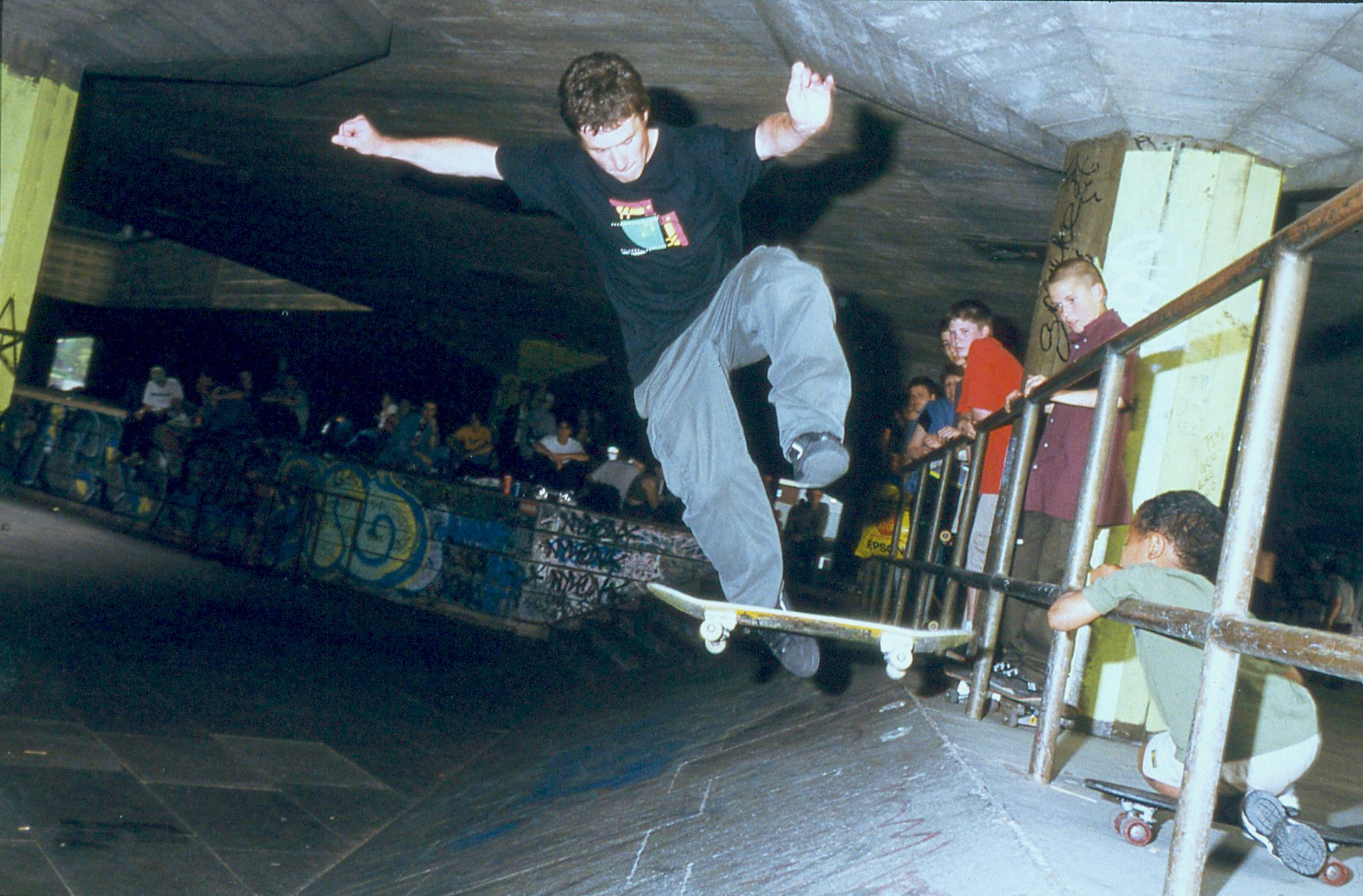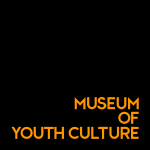

Long Live Southbank Skate Spot!
Words by Ismael Ali Hamid Nasreldin | 07.12.23
If the Southbank Skate Spot was a book, it certainly could be judged by its striking ‘cover’ as a place of legend, as is evident from a first glance at the cove-like enchanting design. The space, known to many as Southbank or even just 'sb’ to the regulars, is a DIY skate spot occupied and cared for by a skateboarding community and homed in the undercroft of the Southbank Centre's Royal Festival Wing. This preserved site of heritage is an organic wonder in the world of youth culture; a place of pilgrimage and prestige. The Southbank Undercroft is a subcultural mecca that has attracted an abundance of converging tenets shaped by historic currents of the skate scene.
Subcultures such as skateboarding, BMXing and graffiti have joined forces at the southbank undercroft since the 1980s, setting the stage for a place of grassroots creativity and progressive activism. In addition to naturally nurturing young peoples first hobbies, the Southbank Skate Spot simultaneously influences personal tastes, skate styles, fashion and political direct action. Above the undercroft sits the Southbank Centre, one of Europe's busiest centres for art, although it’s safe to say the activities of the undercroft are much more enticing and inspiring to many young people and passing visitors. This is because the skate spot and the community it fosters are at once both a microcosm and an epicentre for youth culture. After a hostile history it’s only recently the Southbank Centre began to embrace the presence of skateboarding in the undercroft.
Origin
In 1968, the Queen Elizabeth Hall, Purcell Room and Hayward Gallery of the Southbank Centre joined the already existing Royal Festival Hall, intending to “create a powerhouse of artistic provision”. Unintentionally the undercroft beneath these joint venues really did become a powerhouse of artistic provision, providing blueprints for alternative ways of thinking and collectivising, evolving from the underground.
The centre architects, despite working for the GLC (Greater London Council), were part of a radical avant-garde architecture collective ‘archigram’ and so left a ‘weird’ and random looking area of space underneath, known as the undercroft. When the building works were completed, Southbank Centre inadvertently launched a by-venue for the creative and performative arts as this otherwise unused space became what we now know as the Southbank Skate Spot.
Skateboarding reached the UK by the 1970s, meaning the dead spaces of the UK were now being seen and interpreted through the eyes of skateboarders for the first time. 5 years on the undercroft remained dormant, until 1973 when eagle-eyed skaters realised it had everything early skateboarding could ask for. Fundamental elements of the space, being the smooth flat ground, inclines, areas to ollie (jump) up, down or over all “just makes it amazing for the act of riding a skateboard” said Ben Powell, the founder of Sidewalk the famous British skate magazine.
“The thing about skateboarding at the southbank, you don’t have to be into art, you don’t have to be going into a gallery you don’t have to be into a particular artist, you don’t have to be into music, you can walk past there you can see some kids skating and see some kids doing graffiti and that’s inspirational for the everyday person. That is inclusive, not exclusive“. Ben Powel, 2013
Importance & Impact
“It’s come from the skaters themselves, generations of skateboarders now going back decades, it's part of the public facing bit of the Southbank land and is for me part of the heritage of that wonderful cultural area of London” Ben Bradshaw MP and Former Culture Secretary
The Southbank skate spot gets many honourable mentions worldwide. In addition to captivating the pedestrian tourists walking by, the skate spot attracts people, especially youth, from far and wide, making it one of those “locations that go down in folklore” according to the UK musician Rodney P. But it’s not a tale without battle, and an uphill struggle against established authority that has only entrenched its lore and importance. Thanks to Long Live Southbank campaigns it continues to be the oldest surviving skateboard spot.
Southbank Skate Spot became the headquarters for the UK skate scene, acting as a home stadium welcoming international skateboarders. But the scope of inspiration and placemaking at southbank is far from restricted within the British Isles, rather it’s in the collective consciousness of skaters and the connected scenes worldwide. It’s Tony Hawk, and his video games that we have to thank for this. The infamous Southbank undercroft was recreated virtually and appears in the game with london-themed quests, such as ‘wall-riding’ big red London buses and pinching police officers hats, a slightly cheekier and playfully mischievous atmosphere which the southbank skate scene invoked. Providing world wide skaters with an opportunity to experience, although virtually, the fabled ramps.
Cult streetwear brand Palace, began first as a friendship group essentially raised, reared and then released from out the grimy Southbank undercroft. Palace founder Lev Tanju became a part of the emerging "Palace Wayward Boys Choir" alongside the group of young creatives including Lucien Clarke and Blondey McCoy, notable characters from the early 2000s scene. Without the Southbank Skate Spot, Palace would not be the brand we recognise today. The presence and atmosphere of the Southbank undercroft exists in a symbiotic relationship with the wider context of London and the UK skate scene. Southbank Skate Spot is a melting pot for the community, where intersections converge and tricks, tips and tastes are all traded. Skateboard culture breeds creativity, especially within hubs of community activity found at a skate spot like Southbank, and many have documented the histories and stories through the years in classically DIY mediums such as zines. James Edson (member of PWBC) created Rabbit Hole, a hand made zine of risograph printed photographs entailing community spirit and collective joy captured on Edson’s camera, frequently set at southbank skate spot, spanning 25 years of skating escapades in the London skate scene, of which southbank has been integral to. The Long Live Southbank campaign explained the upskilling environment perfectly, “Southbank undercroft is a rare free creative space in the very heart of London. It will enrich London's cultural life, give young people positive and creative outlets as well as a much-needed sense of community”.
Long Live Southbank
Southbank Skate Spot did not become legendary accidentally, nor overnight, but due to continued collective efforts from the community to preserve it. For a long time pressure from the GLC and owners of the undercroft focused on ridding the space of skateboard activities, repeatedly marshalling skaters into smaller spaces, rather than nurturing the creativity and community that exists solely because the undercroft is skated. Since the mid ‘90s, Southbank Centre officials were known to turn lights off, spread gravel on the floor and install anti-skating architecture such as holes drilled into the floor in an effort to deter skaters from congregating. Did it work though? Nah! Perseverance meant the skating scene in the undercroft survived.
In March 2013, the Southbank Centre announced plans to redevelop the southbank site, including the infilling of the undercroft with commercial units, which would have resulted in the eradication of the cultural heritage site. Misunderstanding the cherished and sentimental place that the Southbank skate spot holds within the personalities, hearts and lives of the London skate scene. Southbank Centre suggested relocation to a purpose built skatepark 100m down the river as a means of solving the problem of ‘what will happen to the skaters?’. In response, the skate community rallied together and began a counter campaign, pulling on public support and fundraising. A grassroots organisation called Long Live Southbank (LLSB) emerged, composed of skaters and supporters all determined to ‘Save Southbank’!
LLSB called for ‘Preservation not Relocation’, arguing a historical restoration is necessary and rejecting what they deemed as the culturally hierarchical outlook of Southbank Centre whereby art and culture that makes money is favoured over organically developed and community led cultural phenomena.
Campaign Ideology & Successes
Politically minded young people of the Southbank community alongside determined and defiant skaters, worked together as activists for the LLSB campaign. This activism led to gaining upwards of 64,000 petition signatures, over 70,000 LLSB members, 100% support at local resident meetings, the skate spot listed as ‘asset of community value’ and was debated in parliament. All achieved in just nine months of the campaign's inception. LLSB members then hand (and feet pushing their skateboards) delivered 14,000 individual objections to the festival wing planning application to the Lambeth Council Town Hall which resulted in the pausing of the Southbank Centre's application for 6 months. This consequently caused Southbank Centre to lead their own counter-campaign to LLSB, aiming to raise support for their new plans and against the skateboard community of the undercroft.
The campaign was immensely successful and secured the long term future of the undercroft in addition to acquiring the planning permission to restore legendary parts of the space last skated in 2004 due to being blocked off. The renovation was completed in June 2019, after 6 years of community outreach, collective activism and creative fundraising, restoring skateable ground and 426 sqm of recovered skate space. Aligning with community spirit and grass roots modes of success, the majority of fundraising was crowdfunded, proving public devotion went as far as financial solidarity. In addition to financial support and backing from corporate sponsors, including Palace and Supreme too, Long Live Southbank collaborated with Boiler Room in 2018 for a ‘fundraver’ event with profits going directly to cover renovation. Notable DJs performed, such as Mall Grab, of whom it’s worth guessing was chosen partly because of his name, ‘mall grab’ being a vernacular skateboarding term referring to a way of holding your skateboard (by the trucks) that may lead to playful ridicule from skaters. The Boiler Room x Long Live Southbank Fundraver stands as a testament to how much can be achieved by young people drawing in iconic entities to fight for a common cause and actively caring both about the heritage of a space as well as the future generations who will use it.
@southbankatm
Another honourable contribution to youth culture and resistance movements is the LLSB report, released in 2021, intended to assist and guide fellow grassroots groups working to protect and preserve their right to a specific space having got what they demanded from the very get go without compromise. ‘Preservation, not Relocation: Space and Why It Matters’ is a freely readable and downloadable pdf. The report is full of ‘thoughts from the Long Live Southbank community and independent projects concerning creative space’, proving LLSB is dedicated to grassroots campaigning and DIY skate movements, now sharing its experience, skills and successes to help aid others.
Thanks to LLSB and its contributors, today the skate scene in the Southbank undercroft is still thriving, and skaters from around the world visit, making up for the 15 years of lost skate space and time, now enjoying the full dimensions of the area that had been blocked off. @southbankatm is an instagram page dedicated to documenting and sharing what is happening at southbank ‘at the moment’. Skaters of southbank undercroft and the LLSB organisation have a much better and mutually beneficial relationship now more than ever before with the Southbank Centre. The campaign to save southbank proved the capabilities, creativity and determined defiance of the community, Southbank Centre projects from time to time are now delivered in collaboration with LLSB, rather than in opposition.














